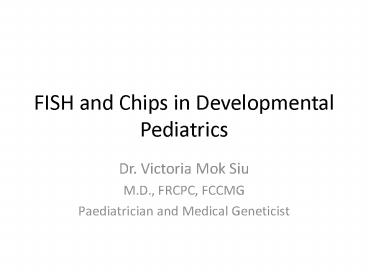FISH and Chips in Developmental Pediatrics - PowerPoint PPT Presentation
1 / 48
Title:
FISH and Chips in Developmental Pediatrics
Description:
Inactivation of myostatin may result in muscle growth. Use of myostatin inhibitors is being investigated for a wide range of disorders, ... – PowerPoint PPT presentation
Number of Views:182
Avg rating:3.0/5.0
Title: FISH and Chips in Developmental Pediatrics
1
FISH and Chips in Developmental Pediatrics
- Dr. Victoria Mok Siu
- M.D., FRCPC, FCCMG
- Paediatrician and Medical Geneticist
2
Objectives
- Understand the use of genetic diagnostic tests,
specifically FISH and CGH - Recognize dysmorphic and behavioral patterns
associated with genetic diagnoses - Be able to access genetic databases for diagnosis
and management
3
Where to go for help
4
www.genetests.org
5
(No Transcript)
6
(No Transcript)
7
(No Transcript)
8
(No Transcript)
9
(No Transcript)
10
OMIM
11
(No Transcript)
12
Investigation of a non-dysmorphic child with
autism/developmental delay
- First tier investigations
- Hearing assessment
- Verify newborn biochemical screening results or
assess for the possibility of a metabolic
disorder - TSH
- Lactate, ammonia, amino acids
- Urine screen MPS, organic acids, amino acids
- Chromosomes (likely to become microarray testing
when more widely available) - DNA testing for Fragile X syndrome
- Second tier investigations
- PTEN molecular testing, if macrocephalic
- MECP2 testing, if female
- Microarray analysis
- MRI of brain
13
When to go FISHing
- routine G banded karyotype
- FISH
- telomere probes
14
Giemsa-banded karyotype
15
FISH - region-specific probe
Can detect specific microdeletion syndromes Must
specify which probe is to be used
16
22q microdeletion syndrome
- Congenital heart defect
- Cleft palate nasopharyngeal regurgitation
- Immunodeficiency
- Short palpebral fissures
17
Williams syndrome 7q
- Stellate iris
- Periorbital puffiness
- Thick lips
- Long philtrum
- Cocktail party chatter
- Hyperacusis
- SVAS
18
Williams Syndrome Are people different from
shapes?
Am J Ment Retard. 2001 10694-107
Exp Brain Res. 2004 157137-46
19
Smith-Magenis syndrome 17p11.2
- Polyembolokoilomania (foreign objects in all
orifices) - Self-hug
- Limited speech
20
Smith-Magenis syndrome 17q
www.prisms.org
21
Disturbance of circadian rhythm in Smith-Magenis
syndrome
Treatment beta-blocker and melatonin
22
Prader-Willi syndrome 15q
- Initial FTT and hypotonia
- Thick saliva
- Pain insensitivity
- Good with puzzles
- Almond-shaped eyes
- Onset of obesity around 2 to 3 years
www.pwsausa.org
23
Angelman syndrome 15q
- Acquired microcephaly
- Absent speech
- High-stepping gait
- Seizures by 2-3 yr
- prognathism
www.angelman.org
24
Both Prader-Willi syndrome and Angelman syndrome
may be caused by a 15q11-13 microdeletion. These
conditions involve imprinting.
http//www.mgm.ufl.edu/images/driscoll/Fish20pic
20Gradient.gif
25
Genomic Imprinting an epigenetic phenomenon
- Epigenetic modifications reversible changes of
DNA methylation pattern and chromatin structure
that can affect gene expression - Genomic imprinting differential expression of a
gene, depending on which parent it was inherited
from - (Reproductive Health 200416)
26
Genetics of PWS and AS
- The genes associated with Prader-Willi syndrome
(SNRPN) and Angelman syndrome (UBE3A) are located
in the same region of chromosome 15
SNRPN UBE3A
SNRPN UBE3A
27
Differential expression of the PWS and AS genes
In a normal individual
paternal
maternal
SNRPN UBE3A
SNRPN UBE3A
methylated
methylated
28
Chromosomal deletion of 15q11-13
- Angelman syndromedeletion on 15 inherited from
mother
- Prader-Willi syndromedeletion on 15 inherited
from father
SNRPN UBE3A
SNRPN UBE3A
29
Chromosomal deletion in PWS and AS
- Usually de novo, with parental chromosomes being
normal - Different phenotypes depend on parental origin of
the deleted chromosome
30
Sometimes with PWS or Angelman syndrome, FISH for
15q microdeletion is normal
31
Uniparental disomy a pair of chromosomes
inherited from the same parent
- Prader-Willi syndromeboth 15 chromosomes from
mother
- Angelman syndromeboth 15 chromosomes
inherited from father
SNRPN UBE3A
SNRPN UBE3A
SNRPN UBE3A
SNRPN UBE3A
32
Strategy for testing for PWS and AS
- Methylation studies to determine if alleles from
both parents are present - If abnormal methylation, do FISH to differentiate
between microdeletion and UPD - (if you do only FISH, you will miss 30 of cases
of PWS or AS)
33
Rett syndrome
- Acquired microcephaly
- Developmental plateau/regression
- Seizures
- Handwringing
- Hyperventilation
- Abdominal bloating
- Bruxism
34
Rett syndrome is another epigenetic disorder
- The normal MeCP2 protein is involved in
maintaining DNA methylation (ie inhibiting gene
expression) - With a mutation in MeCP2, too many genes remain
activated (like an orchestra where all the
instruments are playing at once)
35
Overlap between symptoms of Angelman syndrome and
Rett syndrome
- Acquired microcephaly
- Seizures
- Lack of speech
36
Multiple subtelomeric FISH probes
- Used to detect subtelomeric deletions
- Not useful for duplications or translocations
unless there is an accompanying deletion
37
Microarray CGH
- To detect variation in copy numberie. small
deletions or duplications - Need to compare with parental DNA
www.molgen.mpg.de
38
duplication in Xp11-p21.1
http//www.genetik-osnabrueck.de/english_aCGH.html
39
Other behaviors to watch for
40
Diet and eating habits
- Low protein
- urea cycle defect, aminoacidopathy
- Avoidance of fruits
- fructose intolerance
- Nasopharyngeal reflux
- 22q deletion
41
Sleeping habits
- Sleep apnea
- Prader-Willi syndrome
- Altered circadian rhythm
- Smith-Magenis syndrome
42
Speech patterns
- Echolalia
- Fragile-X syndrome
- cocktail party chatter
- Williams syndrome
43
Behavior with illnesses
- Undue lethargy and vomiting, or unusual odour of
urine or sweat mousey PKU - sweaty feet isovaleric acidemia
- sweet MSUD
44
Whats new in gene therapy?
45
Normal Duchenne muscular dystrophy
Dystrophin stain
46
Dystrophin protein is involved in DMD and BMD
47
Potential treatments for DMD
- Utrophin upregulationturn on another gene to
make a protein similar to dystrophin - Myostatin inactivationturn off a gene to
enhance muscle growth
48
Myostatin
- Normally acts to inhibit muscle cell growth
- Inactivation of myostatin may result in muscle
growth - Use of myostatin inhibitors is being investigated
for a wide range of disorders, including muscular
dystrophies and muscle wasting associated with
HIV































